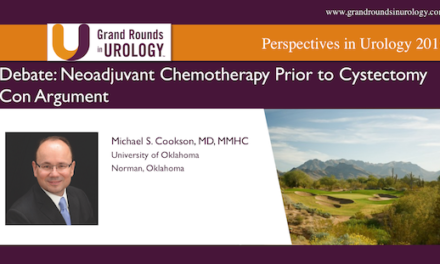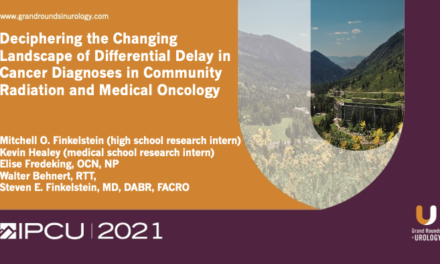Dr. Alan H. Bryce, MD, presented “The DECIPHER Marker Can Predict Chemotherapy” at the 26th Annual Perspectives in Urology: Point-Counterpoint, November 10, 2017 in Scottsdale, AZ
How to cite: Bryce, Alan H. “The DECIPHER Marker Can Predict Chemotherapy” November 10, 2017. Accessed Apr 2024. https://grandroundsinurology.com/The-DECIPHER-Marker-Can-Predict-Chemotherapy/
Summary:
Alan H. Bryce, MD makes the pro side of the argument that the DECIPHER marker is an effective tool for predicting a patient’s response to chemotherapy. He also summarizes the ongoing trials and research regarding this specific biomarker. This is a counter argument to Robert Abouassaly‘s lecture, “Can The DECIPHER Marker Predict Chemotherapy?”
The DECIPHER Marker Can Predict Chemotherapy
Transcript:
This will be I think a bit different than some of our other point-counterpoints. I don’t expect all of the fireworks. I hope you’re not disappointed by that.
A disclaimer: I’m going to start right out with this. What I am presenting to you really is unpublished proprietary data provided by the researchers and the company. It hasn’t yet been peer reviewed. It hasn’t yet been published. In fact I’ve never seen it before being asked to prep for this. So really I’m not arguing pro. What I’m going to do is I’m going to give you the data and give you something to think about. This is what is coming down the pipe hopefully this is something that does become a reality. Certainly any test that predicts chemotherapy is a good thing, but having said that again I don’t have access to the raw data. I don’t have access to the background, so whether you like it or not look at this as a sneak peak into where we hope the field is going. All right, so we know that patient response to chemotherapy is variable. It’s difficult to predict. As you saw, you know, the response rates form chemotherapy for example in bladder are somewhat disappointing, and the fact of the matter is that with most chemotherapies we talk about response rates, maybe 20, 30, 50%. Rare do we get more than that, so there is a strong motivation across all cancer types, not just prostate cancer, bladder cancer or GU cancer, but across all cancers we would love to have the biomarkers that predict for response. The fact of the matter is we don’t have biomarkers for many cancer drugs at all. Most of them we are using more generally and broadly without a biomarker, and yet one would think that there is a way to profile a tumor to say what is the gene expression, what is the protein expression, certain tumors that are dependent on certain pathways ought to be more responsive to certain chemotherapeutics than others. Certainly, I mean it makes perfect sense, but it’s been difficult to come up with that.
So DECIPHER has come up with this test looking at RNA expression. The attraction of RNA expression, of course is that RNA expression should then be translated into protein expression, and the reason we don’t see proteomic assays is because proteomics is still a fairly nascent field, hard to actually do, hard to do in real time especially, so RNA is the closest we can get t talking about actual protein expression in a tumor, and we know against this background that chemotherapy has had a resurgence in prostate cancer care from the STAMPEDE data, from the LATITUDE data, from RTOG531 and 621, hopefully we’re past the age where there was nihilism about the use of chemotherapy in prostate cancer. It has a major role to play, so the question hopefully is then how do you pick out the patients who are going to benefit most.
All right, is there a molecular signature? That is what this talk is about. So of course we always start with cell line studies. There are multiple cell lines out there that we can test against, and there are multiple ways in which drug sensitivity is tested against cell line panels. I mean there’s gel matrices, there’s 3D modeling, there are commercially available cell lines available, and so what DECIPHER did here is they looked at RNA expression data from these cell lines, they tried to correlate it with drug sensitivity data initially so this was data mining, and then they moved on to actually doing assays. Okay, if anybody is good at math, you can explain this to me. I’m well past this although I think my son very soon will be trying to explain these things to me or asking him to help so I need to study. So what they ultimately did was they developed what they call this drug score, so they have a coefficient of relative expression of this list of genes, right, these RNA assays. I don’t know what these straight lines mean anymore. Boy, it’s been a long time, but in any sense, what they are talking about is a numerical score to talk about does the patient’s tumor express the sensitivity expressed by the cell lines, does that translate over to what is seen in actual patients to say will you respond to docetaxol or not? In general the higher score saying higher sensitivity for a drug gene pair. They ended up looking in available tissue banks, 15,000 radical prostatectomy patients, and 900 of those patients with treatment looked at their long-term outcomes, and then compared that to data derived from 20 cancer cell lines, and developed these scores as we were just looking at to say can they predict for the response to chemotherapy.
All right, so what you get is graphs like this. This is a bit easier to read, right, for the person who is mathematically challenged. So what you end up seeing is a difference, a separation between the Cisplatin sensitive or drug sensitive versus drug resistant population, in this case for Cisplatin. Over here the same thing for paclitaxel, right, and you see a bit more separation on the platinum side than you see for paclitaxel. Over here we’re talking about bladder cancer cell lines. Over here we’re talking about breast cancer cell lines, but this is how these scores are generally calculated.
And what they then went on to do is to look at different drugs with these cell lines, deriving this data and trying to find is there a statistically significant separation. In bladder cancer they said yes with cisplatin, no with paclitaxel. Down here with breast you see positive scores with some of these data sets in paclitaxel, but negative with others.
But then we get this so looking at paclitaxel one would hypothesize, right, mechanistically an anti-microtubule drug should be correlated with tumor cell proliferation, microtubule assembly being important during the mitotic process, and you do see a positive correlation here right nice and tightly bound, correlation coefficient 0.75, which is very encouraging. With olaparib, this is correlation the respond to olaparib, so this is a PARP inhibitor with the expression of DNA repair genes, so absence of DNA repair genes should say that a PARP inhibitor should be efficacious, we’ll go into this more tomorrow when we talk about the use of genomic signatures in the treatment of prostate cancer, but here we expect a negative correlation and indeed it is seen so this is the type of score you are trying to develop for prostate cancer, for response to chemotherapy. So this is the prostate cancer data looking at various drugs that have been tested at different times in prostate cancer, very traditional drugs, docetaxel, paclitaxel, estramustine, kind of all familiar over many years, and what is encouraging in this is that, you know, where we see red circles, it should be a negative correlation, the blue is positive, and the blue and the red at least line up theoretically with the mechanism of action of the drugs, so we would expect that for docetaxol you would see positive correlation down here. Here is cell cycle regulation, so again having to do with the rate of proliferation. Coagulation, what that would have to do with docetaxol I have no idea, so the fact that it is negative is probably a positive thing, right, and you see that these do sort at least in an encouraging way such that to say with taxanes you have correlation with cell cycle, with proliferation with DNA repair, with alkylating agents you have a negative correlation with AR, a positive correlation with norendocrine sub-type, this reflects how we actually use these drugs in clinical practice. With PARP inhibitor and pardon the type there, correlation with basal sub-type because as we have begun to understand this from TCGA data, there is a correlation between the presence of the DNA repair gene defects and basal sub-types.
Ultimately this is where the data is supposed to come together. This is a heat map of the 15,000 radical prostatectomy patients so what you see up on the top here is the various categories or say subtypes of prostate cancer, so those patients with ETS fusions, basal like versus luminal, low AR activity versus high, radiation sensitivity as we understand it, and what you see down here is a heat map with the various drugs, and what you end up seeing is these cluster according to the pattern of gene defect, so this is a pattern of gene defect, so this is over expression, under expression, activity, high low, and you see clustering for basalness, for AR activity, for radiation sensitivity and that the chemotherapies end up clustering by drug module. I mean this is the kind of result when we look at drug sensitivity assays and other cancers, this is what we expect to see to say, all right, if you’ve got the clustering you’ve got a signal. The question is can you translate that signal into a test that can be run in real time, and is that signal powerful enough to lead to actual differences in clinical outcomes.
So where this stands is the very early pre-clinical data looks promising. Things are clustering the way we want them do. Perhaps there is going to be applicability. What we don’t have yet, and further validation is very necessary. What we don’t have yet is application of this to a prospective, randomized, clinical trial. Really that is where this has to go, and you know, at the Mayo Clinic we’re very familiar with this. One of my mentor sin breast cancer had a very exciting assay for the pharmacogenomic prediction of Tamoxifen efficacy. Everyone was convinced it was going to work in two large randomized clinical trials. I mean it failed abjectly to the shock of the assemble people at the conference at the time. So we need further validation. We need that prospective clinical trial, but nevertheless this is the kind of data that makes us say we need to move forward with this and look at it, and these groups were distinguishable, which they ought to be by AR activity by basal versus luminal sub-type, and the sensitivity profiles are at least consistent theoretically with what you would expect for the chemotherapy.
So I would say in the pro sense, the technology is certainly a step in the right direction, improved treatment outcomes, certainly exciting data. We look forward to seeing this released publicly and hopefully parsed out and tested further. Thank you.




